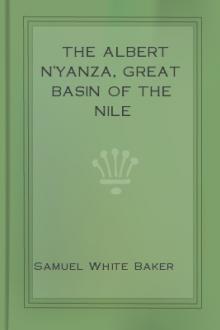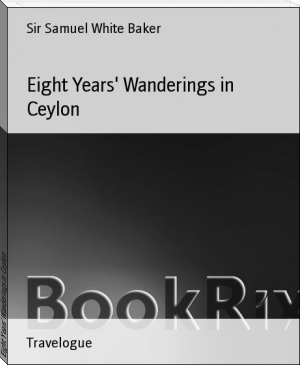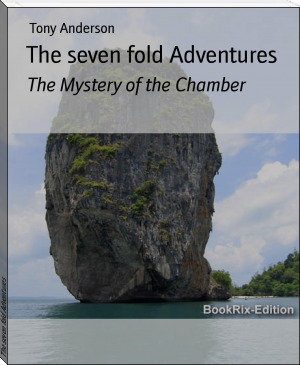The Albert N'Yanza, Great Basin of the Nile by Samuel White Baker (best ebook reader for chromebook .txt) 📖

- Author: Samuel White Baker
- Performer: -
Book online «The Albert N'Yanza, Great Basin of the Nile by Samuel White Baker (best ebook reader for chromebook .txt) 📖». Author Samuel White Baker
was a female, with a head far inferior in size and solidity to that of
the male.
The temple shot, and that behind the ear, are equally fatal in Africa as
in Ceylon, provided the hunter can approach within ten or twelve yards;
but altogether the hunting is far more difficult, as the character of
the country does not admit of an approach sufficiently close to
guarantee a successful shot. In the forests of Ceylon an elephant can be
stalked to within a few paces, and the shot is seldom fired at a greater
distance than ten yards: thus accuracy of aim is insured; but in the
open ground of Africa, an elephant can seldom be approached within fifty
yards, and should he charge the hunter, escape is most difficult. I
never found African elephants in good jungle, except once, and on that
occasion I shot five, quite as quickly as we should kill them in Ceylon.
The character of the sport must vary according to the character of the
country; thus there may be parts of Africa at variance with my
description. I only relate my own experience.
Among other weapons, I had an extraordinary rifle that carried a
half-pound percussion shell—this instrument of torture to the hunter
was not sufficiently heavy for the weight of the projectile; it only
weighed twenty pounds: thus, with a charge of ten drachms of powder,
behind a HALF-POUND shell, the recoil was so terrific, that I was spun
round like a weathercock in a hurricane. I really dreaded my own rifle,
although I had been accustomed to heavy charges of powder and severe
recoil for many years.
None of my men could fire it, and it was looked upon with a species of
awe, and was named “Jenna el Mootfah” (child of a cannon) by the Arabs,
which being far too long a name for practice, I christened it the
“Baby;” and the scream of this “Baby,” loaded with a half-pound shell,
was always fatal. It was far too severe, and I very seldom fired it, but
it is a curious fact, that I never fired a shot with that rifle without
bagging: the entire practice, during several years, was confined to
about twenty shots. I was afraid to use it; but now and then it was
absolutely necessary that it should be cleaned, after lying for months
loaded. On such occasions my men had the gratification of firing it, and
the explosion was always accompanied by two men falling on their backs
(one having propped up the shooter), and the “Baby” flying some yards
behind them. This rifle was made by Holland, of Bond Street, and I could
highly recommend it for Goliath of Gath, but not for men of A.D. 1866.
The natives of Central Africa generally hunt the elephant for the sake
of the flesh, and prior to the commencement of the White Nile trade by
the Arabs, and the discovery of the Upper White Nile to the 5 degrees N.
lat. by the expedition sent by Mehemet Ali Pasha, the tusks were
considered as worthless, and were treated as bones. The death of an
elephant is a grand affair for the natives, as it supplies flesh for an
enormous number of people, also fat, which is the great desire of all
savages for internal and external purposes. There are various methods of
killing them. Pitfalls are the most common, but the wary old bulls are
seldom caught in this manner.
The position chosen for the pit is, almost without exception, in the
vicinity of a drinking place, and the natives exhibit a great amount of
cunning in felling trees across the usual run of the elephants, and
sometimes cutting an open pit across the path, so as to direct the
elephant by such obstacles into the path of snares. The pits are usually
about twelve feet long, and three feet broad, by nine deep; these are
artfully made, decreasing towards the bottom to the breadth of a foot.
The general elephant route to the drinking place being blocked up, the
animals are diverted by a treacherous path towards the water, the route
intersected by numerous pits, all of which are carefully concealed by
sticks and straw, the latter being usually strewn with elephants’ dung
to create a natural effect.
Should an elephant, during the night, fall through the deceitful
surface, his foot becomes jammed in the bottom of the narrow grave, and
he labours shoulder deep, with two feet in the pitfall so fixed that
extrication is impossible. Should one animal be thus caught, a sudden
panic seizes the rest of the herd, and in their hasty retreat one or
more are generally victims to the numerous pits in the vicinity. The old
bulls never approach a watering place rapidly, but carefully listen for
danger, and then slowly advance with their warning trunks stretched to
the path before them; the delicate nerves of the proboscis at once
detect the hidden snare, and the victims to pitfalls are the members of
large herds who, eager to push forward incautiously, put their “foot
into it,” like shareholders in bubble companies. Once helpless in the
pit, they are easily killed with lances.
The great elephant hunting season is in January, when the high prairies
are parched and reduced to straw. At such a time, should a large herd of
animals be discovered, the natives of the entire district collect
together to the number of perhaps a thousand men; surrounding the
elephants by embracing a considerable tract of country, they fire the
grass at a given signal. In a few minutes the unconscious elephants are
surrounded by a circle of fire, which, however distant, must eventually
close in upon them. The men advance with the fire, which rages to the
height of twenty or thirty feet. At length the elephants, alarmed by the
volumes of smoke and the roaring of the flames, mingled with the shouts
of the hunters, attempt an escape. They are hemmed in on every
side—wherever they rush, they are met by an impassable barrier of
flames and smoke, so stifling, that they are forced to retreat.
Meanwhile the fatal circle is decreasing; buffaloes and antelopes,
likewise doomed to a horrible fate, crowd panic stricken to the centre
of the encircled ring, and the raging fire sweeps over all. Burnt and
blinded by fire and smoke, the animals are now attacked by the savage
crowd of hunters, excited by the helplessness of the unfortunate
elephants thus miserably sacrificed, and they fall under countless
spears. This destructive method of hunting ruins the game of that part
of Africa, and so scarce are the antelopes, that, in a day’s journey, a
dozen head are seldom seen in the open prairie.
The next method of hunting is perfectly legitimate. Should many
elephants be in the neighbourhood, the natives post about a hundred men
in as many large trees; these men are armed with heavy lances specially
adapted to the sport, with blades about eighteen inches long and three
inches broad. The elephants are driven by a great number of men towards
the trees in which the spearmen are posted, and those that pass
sufficiently near are speared between the shoulders. The spear being
driven deep into the animal, creates a frightful wound, as the tough
handle, striking against the intervening branches of trees, acts as a
lever, and works the long blade of the spear within the elephant,
cutting to such an extent that he soon drops from exhaustion.
The best and only really great elephant-hunters of the White Nile are
the Bagara Arabs, on about the 13 degree N. lat. These men hunt on
horseback, and kill the elephant in fair fight with their spears.
The lance is about fourteen feet long, of male bamboo; the blade is
about fourteen inches long by nearly three inches broad; this is as
sharp as a razor. Two men, thus armed and mounted, form the hunting
party. Should they discover a herd, they ride up to the finest tusker
and single him from the others. One man now leads the way, and the
elephant, finding himself pressed, immediately charges the horse. There
is much art required in leading the elephant, who follows the horse with
great determination, and the rider adapts his pace so as to keep his
horse so near the elephant that his attention is entirely absorbed with
the hope of catching him. The other hunter should by this tine have
followed close to the elephant’s heels, and, dismounting when at full
gallop with wonderful dexterity, he plunges his spear with both hands
into the elephant about two feet below the junction of the tail, and
with all his force he drives the spear about eight feet into his
abdomen, and withdraws it immediately. Should he be successful in his
stab, he remounts his horse and flies, or does his best to escape on
foot, should he not have time to mount, as the elephant generally turns
to pursue him. His comrade immediately turns his horse, and, dashing at
the elephant, in his turn dismounts, and drives his lance deep into his
intestines.
Generally, if the first thrust is scientifically given, the bowels
protrude to such an extent that the elephant is at once disabled. Two
good hunters will frequently kill several out of one herd; but in this
dangerous hand-to-hand fight the hunter is often the victim. Hunting
the elephant on horseback is certainly far less dangerous than on foot,
but although the speed of the horse is undoubtedly superior, the chase
generally takes place upon ground so disadvantageous, that he is liable
to fall, in which case there is little chance for either animal or
rider. So savage are the natural instincts of Africans, that they attend
only to the destruction of the elephant, and never attempt its
domestication.
CHAPTER VIII.
IBRAHIM’s RETURN.
Ibrahim returned from Gondokoro, bringing with him a large supply of
ammunition. A wounded man of Chenooda’s people also arrived, the sole
relic of the fight with the Latookas; he had been left for dead, but had
recovered, and for days and nights he had wandered about the country, in
thirst and hunger, hiding like a wild beast from the sight of human
beings, his guilty conscience marking every Latooka as an enemy. As a
proof of the superiority of the natives to the Khartoumers, he had at
length been met by some Latookas, and not only was well treated and fed
by their women, but they had guided him to Ibrahim’s camp.
The black man is a curious anomaly, the good and bad points of human
nature bursting forth without any arrangement, like the flowers and
thorns of his own wilderness. A creature of impulse, seldom actuated by
reflection, the black man astounds by his complete obtuseness, and as
suddenly confounds you by an unexpected exhibition of sympathy. From a
long experience with African savages, I think it is as absurd to condemn
the negro in toto, as it is preposterous to compare his intellectual
capacity with that of the white man. It is unfortunately the fashion for
one party to uphold the negro as a superior being, while the other
denies him the common powers of reason. So great a difference of opinion
has ever existed upon the intrinsic value of the negro, that the very
perplexity of the question is a proof that he is altogether a distinct
variety. So long as it is generally considered that the negro and the
white man are to be governed by the same laws and guided by the same
management, so long will the former remain a thorn in the side of every
community to which he may unhappily belong. When the horse and the ass
shall be found to match in double harness, the white





Comments (0)